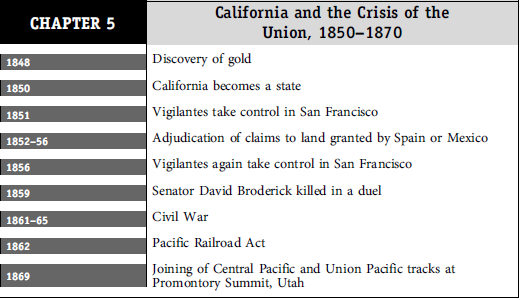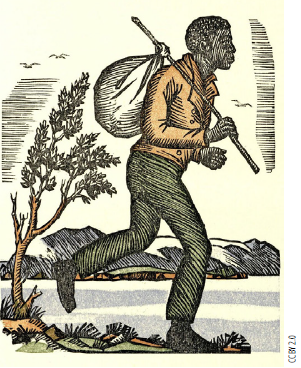5: California and the Crisis of the Union, 1850–1870
- Page ID
- 126962
Main Topics
- Crisis and Conflict in the 1850s
- Californians and the Crisis of the Union
- Economic Growth in a Time of National Crisis
- New Social and Cultural Patterns
- Summary
In 1857, Charles Stovall arrived in California from Mississippi. Archy Lee, a slave who belonged to Stovall’s father, was with him. Upon arriving in Sacramento, Stovall followed the Southern practice of hiring out Lee to work for others, and he took a job himself. California’s state constitution prohibited slavery, however, and by 1857 Californians who opposed slavery, black and white alike, had become practiced in freeing slaves in their state. When Stovall learned of this, he tried to send Lee back to Mississippi, but Lee asserted his freedom and hid in a hotel run by an African American family. Stovall then had him arrested as a fugitive slave. Several white abolitionist lawyers defended Lee. When the judge ordered Lee released, Stovall had him rearrested on a new warrant, issued by David Terry, a state supreme court justice known to support slavery. In an astounding decision, the California Supreme Court ruled that, because Stovall had been ignorant of the law regarding slavery in California, he


This woodcut is from the cover of a book about Archy Lee, by Rudolph Lapp, published in 1969
should not be penalized by the loss of his father’s slave. The court ordered Lee to return to Mississippi with Stovall.
When the two arrived in San Francisco en route to Mississippi, black and white abolitionists were prepared. They had Lee arrested to keep him in the state, and they accused Stovall of holding a slave illegally. San Francisco’s small African American community sought funds throughout the state, alerting opponents of slavery to the case. Some of the most prominent Republican lawyers in the state, led by Edward D. Baker, represented Lee in his third court hearing. They pointed out the absurdities in the supreme court’s ruling and secured a new ruling that Lee was a free man. Stovall, too, was prepared, however, and a federal marshal arrested Lee for violating the Fugitive Slave Law of 1850. Lee went to trial a fourth time, now before a federal commissioner who had come from the South and was presumably pro-slavery. Crowds of whites and blacks argued over the case on the streets as sidewalk orators harangued the crowds. Lee’s lawyers, led by Baker, argued that the 1850 law applied only to slaves who fled from a slave state into a free state, pointed out that Lee had been brought into California with his owner’s permission, and concluded that no federal law had been violated. The commissioner agreed and set Lee free. Soon after, Lee moved to British Columbia, out of the jurisdiction of American law. The experience of Archy Lee dramatically indicates that California, separated by a continent from the center of the controversy over slavery, could not escape the political crisis that slavery engendered in the 1850s.
In 1850, however, the delegates who sat in Colton Hall writing a constitution for the new state of California were separated by a distance of some 1,500 miles from the nearest state. They probably had no idea that their request for statehood would contribute significantly to the emerging national crisis. Yet a crisis had long been approaching and was now hastened by the annexation of Texas and the territories acquired under the Treaty of Guadalupe Hidalgo. California’s application for statehood compounded that crisis. Many sought to stem the conflict but failed, as the sectional crisis over the extension of slavery into federal territory grew to include the institution of slavery everywhere and eventually raised fundamental questions about the nature of the Union and the meaning of American citizenship. The crisis escalated to civil war, and the war brought the abolition of slavery, the redefinition of American citizenship, and the transformation of the federal Union. Though far removed geographically from the debates in Congress and the battlefields of war, California figured significantly in the crisis of the Union, and that crisis brought important changes to California. In 1850, California seemed to be separated by vast distances of unsettled territory from the rest of the United States. Over the next 20 years, California came to be bound much more tightly into the federal Union. At the same time, the state was rapidly changing from a booming mining frontier to an economically and socially diverse society.
Questions to Consider
- How did national political issues affect the new state of California?
- How did federal policy affect Californios and California Indians?
- How did sectional issues, especially slavery, affect Californians in the 1850s?
- What changes came to California as a result of the Civil War?
- How did the state’s economy change in the 1850s and 1860s?
- What role did the federal government play in the development of improved transportation between California and the eastern United States?
- What was the relation between socially defined gender roles and the creation of new social institutions in the 1850s and 1860s?
- Why did California acquire a reputation for religious toleration?
- How did Californians influence national literary development?


